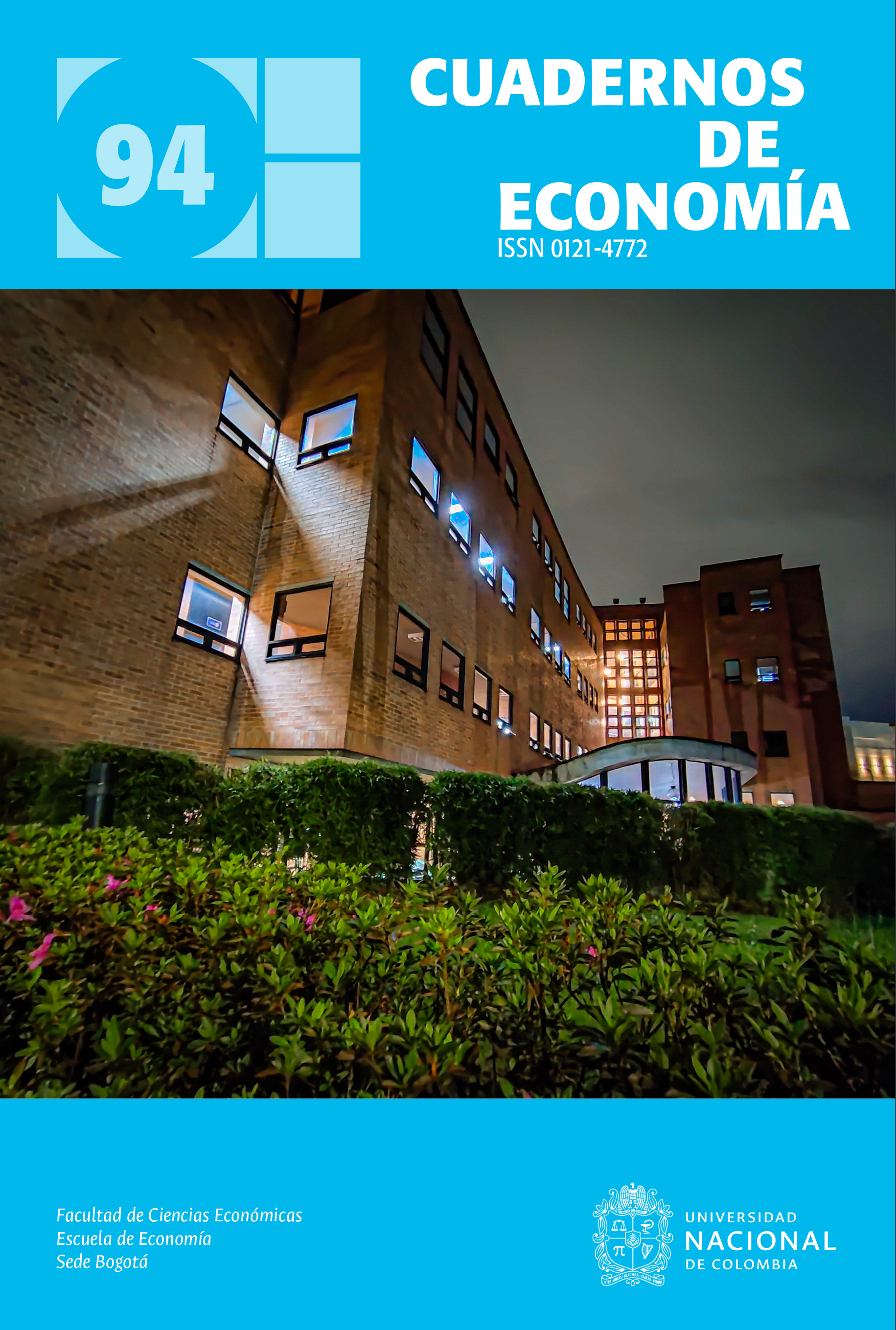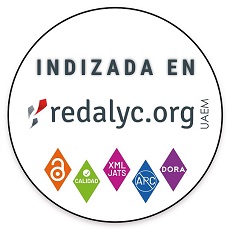Resiliencia e innovación, capacidades impulsoras del rendimiento en empresas de servicios
Resilience e innovation, performance drivers capabilities in service companies
DOI:
https://doi.org/10.15446/cuad.econ.v44n94.107437Palabras clave:
Empresas, administración de negocios, innovación, rendimiento (es)Firms, business administration, innovation, performance (en)
Descargas
El estudio de las capacidades dinámicas y la teoría de la contingencia permitieron definir el objetivo de esta investigación: analizar el efecto mediador de la innovación en la relación resiliencia-rendimiento. El estudio fue cuantitativo y de alcance explicativo. Se usó una muestra de 176 empresas de servicios. El modelo de mediación explicó que la resiliencia permite desarrollar un proceso de estabilización y revitalización que logra responder a cambios; la innovación como respuesta resiliente movilizó los recursos para la creación de valor y continuidad del negocio; y la mediación de la innovación logró producir un efecto positivo significativo que mejoró el rendimiento.
The study of dynamic capacities and the theory of contingency allowed us to define the purpose of this research: to analyze the mediating effect of innovation on the resilience-performance relationship. The quantitative study with an explanatory scope was done. The survey included 176 service companies. The mediation model explained that resilience allows the development of a stabilization and revitalization process that manages to respond to changes, innovation as a resilient response mobilized resources for the creation of value and business continuity; and the mediation of innovation was able to produce a significant positive effect that improved performance.
Referencias
1. Adam, N. A., & Alarifi, G. (2021). Innovation practices for survival of small and medium enterprises (SMEs) in the COVID-19 times: The role of external support. J. Innov. Entrep., 10(15). https://doi.org/10.1186/s13731-021-00156-6
2. Adekola, J., & Clelland, D. (2019). Two sides of the same coin: Business resilience and community resilience. Journal of Contingencies and Crisis Management, 28(1), 50-60. https://doi.org/10.1111/1468-5973.12275
3. Arzubiaga, U., Maseda, A., & Beunza, F. (2019). La empresa familiar ante el reto de la innovación: una mirada al papel de la tradición y el conocimiento pasado. Revista de Dirección y Administración deEempresas, (26), 11-29.
4. Asamoah, D., Agyei-Owusu, B., & Ashun, E. (2020). Social network relationship, supply chain resilience and customer-oriented performance of small and medium enterprises in a developing economy. Benchmarking. An International Journal, 27(5), 1463–5771. https://doi.org/10.1108/BIJ-08-2019-0374
5. Caballero-Morales, S.O. (2021). Innovation as recovery strategy for SMEs in emerging economies during the COVID-19 pandemic. Research in International Business and Finance, Elsevier, 57, 1-9. https://doi.org/10.1016/j.ribaf.2021.101396
6. Castillo-Apriz, J., & Matey De Antonio, A.J. (2020). The mediating role of personnel training between innovation and performance: Evidence from the German pharmaceutical industry. Management Letters / Cuadernos de Gestión, 20(3), 41-52. https://doi.org/10.5295/cdg.180990jc
7. Chowdhury, M., Prayag, G., Orchiston, C., & Spector, S. (2019). Postdisaster social capital, adaptive resilience and business performance of tourism organizations in Christchurch, New Zealand. Journal of Travel Research, 58(7), 1209–1226. https://doi.org/10.1177/0047287518794319
8. Coates, G., Alharbi, M., Li, C., Ahilan, S., & Wright, N. (2019). Evaluating the operational resilience of small and medium-sized enterprises to flooding using a computational modelling and simulation approach: A case study of the 2007 flood in Tewkesbury. Philosophical Transactions of The Royal Society a Mathematical, Physical and Engineering Sciences, 378(2168), 1-15. https://doi.org/10.1098/rsta.2019.0210
9. Cohen, J. (1988). Statistical power analysis for the behavioral sciences. Laurence Erlbaum Associates. https://doi.org/10.4324/9780203771587
10. Cepal (Comisión Económica para América Latina y el Caribe). (2021). Estudio Económico de América Latina y el Caribe (LC/PUB.2021/10-P), Santiago.
11. Darroch, J. (2005). Knowledge management, innovation and firm performance. Journal of Knowledge Management, 9(3), 101-115. https://doi.org/10.1108/13673270510602809
12. De Carvalho, A., Ribeiro, I., Cirani, C., & Cintra, R. (2016). Organizational resilience: A comparative study between innovative and non-innovative companies based on the financial performance analysis. International Journal Innovation, 4(1), 58–69. https://www.redalyc.org/articulo.oa?id=499151079006
13. De Lucas, A. A., del Val, N. M. T., & Gavrila, S. G. (2021). Workplace change within the COVID-19 context: A grounded theory approach. Econ. Res.-Ekon. Istraživanja, 34, 2297–2316. https://doi.org/10.1080/1331677X.2020.1862689
14. Demuner-Flores, M. R. (2021). Capacidad de innovación en empresas mexicanas: mediación en la relación orientación al aprendizaje-rendimiento empresarial. Acta Universitaria, 31, e3185. http://doi.org/10.15174.au.2021.3185
15. Demuner-Flores, M. R., Saavedra, G. M. L., & Cortés, C. M. R. (2022a). PYME: resiliencia, rendimiento y rol mediador de la innovación. Investigación Administrativa, 51(130), 1-19. https://doi.org/10.35426/iav51n130.01
16. Demuner-Flores, M. R., Delgado, C. A., & Vargas, M. E. E. (2022b). Innovación y rendimiento: relación mediada por la orientación al aprendizaje y al mercado en empresas mexicanas. Estudios Gerenciales, 38(162), 82-94. https://doi.org/10.18046/j.estger.2022.162.4706
17. Deutscher, F., Zapkaub, F., Schwens, C., Baum, M., & Kabst, R. (2016). Strategic orientations and performance: A configurational perspective. Journal of Business Research, 69(2), 849-861. https://doi.org/10.1016/j.jbusres.2015.07.005
18. Diario Oficial de la Federación. (2002, 30 de septiembre). Acuerdo por el que se establece la estratificación de las micro, pequeñas y medianas empresas. https://www.dof.gob.mx/nota_detalle_popup.php?codigo=4946386
19. Dijkstra, T., & Henseler, J. (2015). Consistent partial least squares path modeling. MIS Quarterly, 39(2), 297-316. https://doi.org/10.25300/MISQ/2015/39.2.02
20. Doa, H., Budhwarb, P., Shiptona, H., Nguyenc, H., & Nguyend, B. (2022). Building organizational resilience, innovation through resource-based management initiatives, organizational learning and environmental dynamism. Journal of Business Research, 141, 808-821. https://doi.org/10.1016/j.jbusres.2021.11.090
21. Dovbischuk, I. (2022). Innovation-oriented dynamic capabilities of logistics service providers, dynamic resilience and firm performance during the COVID-19 pandemic. The International Journal of Logistics Management, 33(2), 499-519. https://doi.org/10.1108/IJLM-01-2021-0059
22. Duchek, S. (2020). Organizational resilience: A capability-based conceptualization. Business Research, 13, 215–246. https://doi.org/10.1007/s40685-019-0085-7
23. Fernández-Mesa, A., & Alegre, J. (2015). Entrepreneurial orientation and export intensity: Examining the interplay of organizational learning and innovation. International Business Review, 24(1), 148-156. http://dx.doi.org/10.1016/j.ibusrev.2014.07.004
24. Fernández, P. A., & Coca, P. J.L. (2022). The role of innovation in the relationship between digitalization and economic and financial performance. Company-level research. European Research on Management and Business, 28(3), 100190. https://doi.org/10.1016/j.iedeen.2021.100190
25. Ferreira, D., Cruz, L., & Kimura, H. (2018). The trajectory of the ability to innovate and the financial performance of the Brazilian industry. Technological Forecasting and Social Change, 127, 258-270. https://doi.org/10.1016/j.techfore.2017.09.027
26. Foss, N. J. (2020). Behavioral strategy and the COVID-19 disruption. Journal of Management, 46(8), 1322–1329. https://doi.org/10.1177/0149206320945015
27. Hair, J., Hult, G., Ringle, C., & Sarstedt, M. (2021). Primer on partial least squares structural equation modeling (PLS-SEM) (3e). Sage.
28. Hameed, W., Nisar, Q., & Wu, H. (2021). Relationships between external knowledge, internal innovation, firms’ open innovation performance, service innovation and business performance in the Pakistani hotel industry. International Journal of Hospitality Management, 92, 102745. https://doi.org/10.1016/j.ijhm.2020.102745
29. Hayes, A. F. (2022). Introduction to mediation, moderation, and conditional process analysis. A regression-based approach. Third Edition
30. Henrique, T. F., López, G. M., Basso, L., & Areal, N. (2021). Indicators used to measure service innovation and manufacturing innovation. Journal of Innovation & Knowledge, 6(1), 11-26. https://doi.org/10.1016/j.jik.2019.12.001
31. Heredia, J., Aguilar, P., & Sainz, N. (2020). Situación de las PYMES de Hermosillo, Sonora ante la crisis presentada por COVID-19. Revista de Investigación Académica Sin Fronteras, 3(32). https://doi.org/10.46589/rdiasf.vi32.311
32. Hillmann, J., & Guenther, E. (2021) Organizational resilience: a valuable construct for management research? International Journal of Management Reviews, 23(1), 7–44. https://doi.org/10.1111/ijmr.12239
33. Huang, A., & Farboudi, J. M. (2021). Resilience building in service firms during and post COVID-19. Serv. ind. J., 41, 138–167. https://doi.org/10.1080/02642069.2020.1862092
34. Inegi (Instituto Nacional de Estadística y Geografía) (2019a). Censos económicos (INEGI, 2019). Municipios del Estado de México. https://datamexico.org/es/profile/geo/toluca#economic-indicators
35. Inegi (Instituto Nacional de Estadística y Geografía) (2019b). Censos Económicos 2019. La industria restaurantera en México. https://www.inegi.org.mx/contenidos/productos/prod_serv/contenidos/espanol/bvinegi/productos/nueva_estruc/702825199357.pdf
36. Jansen, J., Van Den Bosch, F., & Volberda, H. (2006). Exploratory innovation, exploitative innovation, and performance: Effects of organizational antecedents and environmental moderators. Management Science, 52(11), 1661-1674. https://www.jstor.org/stable/20110640
37. Kraśnicka, T., Głód, W., & Wronka, P.M. (2018). Management innovation, pro-innovation organizational culture and enterprise performance: Testing the mediation effect. Review of Management Science, 12, 737– 769. https://doi.org/10.1007/s11846-017-0229-0
38. Linnenluecke, M. K. (2017). Resilience in business and management research: A review of influential publications and a research agenda. Int. J. Manag. Rev., 19, 4–30. https://doi.org/10.1111/ijmr.12076
39. Manresa, A., Bikfalvi, A., & Simon, A. (2019). The impact of training and development practices on innovation and financial performance. Industrial and Commercial Training, 51(7-8), 421-444. https://doi.org/10.1108/ICT-04-2019-0035
40. Thaise, C. M., Gomes, G., & Carmona, L. J. D. M. (2020). Influence of learning and service innovation on performance: Evidence in Brazilian architectural KIBS. Innovation and Management Review, 17(2), 157-175. https://doi.org/10.1108/INMR-02-2019-0020
41. Millman, E. (2020). The New reality for concerts in COVID: Virtual reality? Rolling Stone. https://www.rollingstone.com/pro/features/virtual-reality-livestreams-covid-1021683/
42. Mojica, E. P., & Martínez, M. del C. (2017). Orientación al mercado, innovación y capacidades competitivas, determinantes del desempeño de las pymes del Estado de Aguascalientes. Revista Iberoamericana de Contaduría, Economía y Administración, 6(18), 1-39. https://doi.org/10.23913/ricea.v6i11.93
43. Mora, M. (1983). La teoría Contingencial en la administración. Cuadernos de Administración, 6(7), 21-32. https://dialnet.unirioja.es/servlet/articulo?codigo=5006596
44. Nunnally, J., & Bernstein, I. (1994). Psychometric theory. (3rd. ed.). McGraw-Hill.
45. Pedron, C., Picoto, W., Colaco, M., & Araujo, C. (2018). CRM system: The Role of dynamic capabilities in creating innovation capability. Brazilian Business Review, 15(5), 494-511. https://doi.org/10.15728/bbr.2018.15.5.6
46. Pérez, C. R. D., García, C. N., & García, B. J. (2021). La empresa española ante la COVID-19: factores de adaptación al nuevo escenario. Retos Revista de Ciencias de la Administración y Economía, 11(21), 5-24. https://doi.org/10.17163/ret.n21.2021.01
47. Prayag, G., Chowdhury, M., Spector, S., & Orchiston, C. (2018). Organizational resilience and financial performance. Annal Tourism Research, (73), 193–196. https://doi.org/10.1016/j.annals.2018.06.006
48. Prayag, I,. & Dassanayake, Ch. (2022). Tourism employee resilience, organizational resilience and financial performance: The role of creative self-efficacy. Journal of Sustainable Tourism. https://doi.org/10.1080/09669582.2022.2108040
49. Richard, P. J., Devinney, T. M., Yip, G.S., & Johnson, G. (2009). Measuring organizational performance: Towards methodological best practice. Journal of Management, 35(3), 718-804. https://doi.org/10.1177/0149206308330560
50. Ringberg, T., Reihlen, M., & Rydén, P. (2019). The technology-mindset interactions: Leading to incremental, radical or revolutionary innovations. Industrial Marketing Management, 79, 102-113. https://doi.org/10.1016/j.indmarman.2018.06.009
51. Ritter, T., & Pedersen, C.L. (2020). Analyzing the impact of the coronavirus crisis on business models. Industrial Marketing Management, 88, 214-224. https://doi.org/10.1016/j.indmarman.2020.05.014
52. Serna-Silva, G., Zenozain, C. C., & Schmidt, U. J. (2018). La resiliencia: un factor decisivo para el crecimiento y mejora de las organizaciones. Gestión en el Tercer Milenio, 20(39), 13-24. https://doi.org/10.15381/gtm.v20i39.14139
53. Skinner, B. F. (2013). Contingencies of reinforcement: A theorical analysis. B. F. Skinner Foundation Reprint Series.
54. Sobaih, A. E. E., Elshaer, I., Hasanein, A. M., & Abdelaziz, A. S. (2021). Responses to COVID-19: The role of performance in the relationship between small hospitality enterprises’ resilience and sustainable tourism development. International Journal of Hospitality Management, 94, 102824. https://doi.org/10.1016/j.ijhm.2020.102824
55. Suliyanto &, Rahab, R. (2012). The role of market orientation and learning orientation in improving innovativeness and performance of small and medium enterprises. Asian Social Science, 8(1), 134-145. https://ccsenet.org/journal/index.php/ass/article/view/14052
56. Supardi, S., & Hadi, S. (2020). New perspective on the resilience of SMEs proactive, adaptive, reactive from business turbulence: A systematic review. Journal of Xi’an University of Architecture & Technology, XII(V), 1260-1275. https://www.xajzkjdx.cn/gallery/125-may2020.pdf
57. Teece, D. (2012). Dynamic capabilities: Routines versus entrepreneurial action. Journal of Management Studies, 49(8), 1395-1401. https://doi.org/10.1111/j.1467-6486.2012.01080.x
58. Teece, D. J., Pisano, G., & Shuen, A. (1997). Dynamic capabilities and strategic management. Strategic Management Journal, 18(7), 509-533. https://www.jstor.org/stable/3088148
59. Torres, A. P., Marshall, M. I., & Sydnor, S. (2019). Does social capital pay off? The case of small business resilience after hurricane Katrina. Journal of Contingencies and Crisis Management, 27(2168-181). https://doi.org/10.1111/1468-5973.12248
60. Tseng, P. H., & Liao, C.-H. (2015). Supply chain integration, information technology, market orientation and firm performance in container shipping firms. The International Journal of Logistics Management, 26(1), 82-106. https://doi.org/10.1108/IJLM-09-2012-0088
61. Vladimirov, V. Z. (2016). SME innovations and performance: The mediating role of product innovation. International Review of Entrepreneurship, 14(2), 209-233.
62. Wang, W., Cao, Q., Qin, L., Zhang, Y., Feng, T., & Feng, L. (2019). Uncertain environment, dynamic innovation capabilities and innovation strategies: A case study on Qihoo 360. Computers in Human Behavior, (95), 284-294. https://doi.org/10.1016/j.chb.2018.06.029
63. Wang, Z., & Wang, N. (2012). Knowledge sharing, innovation and firm performance. Expert Systems with Applications, 39(10), 8899-8908. https://doi.org/10.1016/j.eswa.2012.02.017
64. Wong C. W. Y., Lirn T. C., Yang C. C., & Shang K. C. (2020). Supply chain and external conditions under which supply chain resilience pays: An organizational information processing theorization. Int. J. Prod. Econ, 226. https://doi.org/10.1016/j.ijpe.2019.107610
65. Yu, W., Jacobs, M. A., Chavez, R., & Yang, J. (2019). Dynamism, disruption orientation, and resilience in the supply chain and the impacts on financial performance: A dynamic capabilities perspective. International Journal of Production Economics, 218(C), 352-362. https://doi.org/10.1016/j.ijpe.2019.07.013
Cómo citar
APA
ACM
ACS
ABNT
Chicago
Harvard
IEEE
MLA
Turabian
Vancouver
Descargar cita
Licencia
Derechos de autor 2025 Cuadernos de Economía

Esta obra está bajo una licencia internacional Creative Commons Atribución-NoComercial-SinDerivadas 4.0.
Cuadernos de Economía a través de la División de Bibliotecas de la Universidad Nacional de Colombia promueve y garantiza el acceso abierto de todos sus contenidos. Los artículos publicados por la revista se encuentran disponibles globalmente con acceso abierto y licenciados bajo los términos de Creative Commons Atribución-No_Comercial-Sin_Derivadas 4.0 Internacional (CC BY-NC-ND 4.0), lo que implica lo siguiente:





















